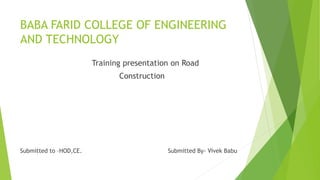
ROAD CONSTRUCTION PRESENTATION.PPTX.pptx
- 1. BABA FARID COLLEGE OF ENGINEERING AND TECHNOLOGY Training presentation on Road Construction Submitted to –HOD,CE. Submitted By- Vivek Babu
- 2. CONTENTS 1. Introduction 2. Road 3. Earth work 4. Pavement 5. Types of pavement 6. Road types 7. Road construction 8. Equipment 9. Price Estimation 10. Conclusion
- 3. INTRODUCTION Development of a country depends on the connectivity of various places with adequate road network. Roads constitute the most important made of communication in areas where railways and airways have not been developed much. India has one the largest roads networks in the world(over 3 million km at present)
- 4. For the purpose of management and administration, roads in India are divided into the following five categories: National Highways(NH) State Highways(SH) Major District Roads(MDR) Other district roads(ORD) Village roads(VR)
- 5. Indian roads network-current status National Highways 1,51,019 km State Highways 1,86,908 km Major Districts Roads 6,32,154 km Village and Other Roads 53,61,710 km Total Roads Length 63,31,791 km NHs are less than 2% of network but carry 40%of total traffic.
- 6. Roads Roads are defined as routes or paths that begin at one destination and lead to another Road is an open, generally public way for passage of vehicles people, and animals.
- 7. Earth Work Soil filling Spreading and Levelling Compaction
- 8. Soil compaction is the process to increase the soil density in order to make use the ground surface for development, i.e., building, road, etc. COMPACTION
- 9. Pavements pavement is finished with a hard smooth surface. It helps to make them durable and able to withstand traffic and the environment. They have a life span of between 20-30 years Types of pavements: 1. Flexible pavement 2. Rigid pavement
- 10. 1. Flexible Pavement Flexible pavement are those which are surfaced with bituminous or asphalt materials. It’s flexible since the total pavement structure bends or deflects due to the traffic loads. Generally this type of pavement requires some sort of maintenance or restoration every 10-15 years.
- 11. 2. Rigid Pavement A rigid pavement structure is composed of a hydraulic cement concrete surface course and concealed base and sub base courses. The surface course is the rigid layer and provides the majority of strength. While in case of rigid pavement most of the load carries by slab itself and slight load goes to the underlying strata.
- 12. Road types Earth road and Gravel road Water bound macadam(WBM) Bituminous or Blacktop road Cement Concrete road
- 13. Road Construction 1. Preparation of the existing base course layer The existing surface is prepared by removing the pot holes or rust if any. The irregularities are filled in with premix existing pavement is extremely way, a bituminous leveling course of adequate thickness is provided to lay a bituminous concrete surface on a binder course instead of directly laying it on a WBM.
- 14. 2. Application of tack coat It is desirable to lay AC layer over a bituminous base or binder course. A tack coat of bitumen applied at 6.0 to 7.5 kg per 10 sq.m area, this quantity may be increased to 7.5 to 10kg for non-bituminous base.
- 15. 3. Preparation and placing of premix The premix is prepared in a hot mix plant of a required capacity with the desired quantity control. The bitumen may be heated up to 150- 177 deg C and the aggregate temperature should not differ by over 14 deg C from the binder temperature. The hot mixed material is collected from the mixture by the transporters, carried to the location is spread by a mechanical paver at the temperature of 121 to 163 deg C. The chamber and the thickness of the layer are accurately verified. The control of the temperature during the mixing and he compaction are of great significance in the strength of the resulting pavement structure.
- 16. 4. Rolling A mix after it is placed on the base course is thoroughly compacted by rolling at a speed not more then 5km per hour. The initial or break down rolling is done by 8 to 12 tones roller and intermediate rolling is done with a fixed wheel pneumatic roller of 15 to 30 tones having a tyre pressure of 7kg sq.cm.
- 17. 5. Quality control of bituminous concrete construction The routine checks are carried out at site to ensure the quantity of the resulting pavement mixture and the pavement surface. Periodical checks are made for: 1. Aggregate grading 2. Grade of bitumen 3. Temperature of aggregate 4. Temperature of a paving mix during mixing and compaction
- 18. 6. Finished surface The AC surface should be checked by a 3.0 m straight edge. The longitudinal undulations should not exceed 8.0 mm and the number of undulation higher not exceed 10 in a length of 300 m. the cross-traffic profile should nothave undulations exceeding 4.0mm.
- 19. Equipment Compacting material (vibratory roller) Dozer and scraper Power shover, shovels Concrete mixer Watering devices Mild steel sections and blocks Barricading Signage board
- 20. Price Estimation According to some Indian experts, the cost of constructing a bitumen road in India ranges from approximately INR 5 crore to INR 10 crore per kilometer, depending on the factors mentioned above. However, it’s essential to note that these costs can change over time due to inflation and market fluctuations. According to some Indian experts,the cost of constructing a rigid concrete road in India ranges from approximately INR 3 crore to INR 6 crore per kilometer,but it requires more skilled labour and the machinery used in this is way expensive than from bitumen road construction instruments . However,in this also price fluctuates according to inflation in market
- 21. Conclusion Fundamentals of road construction consists of the following topics: Construction management overview Preliminary investigations Setting out Earthworks Pavements Drainage Roadsides